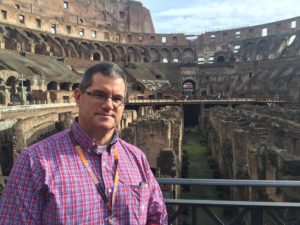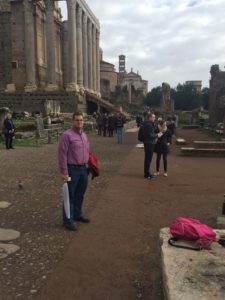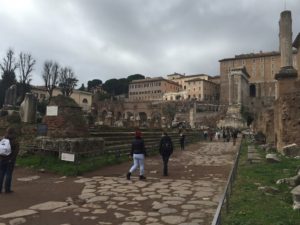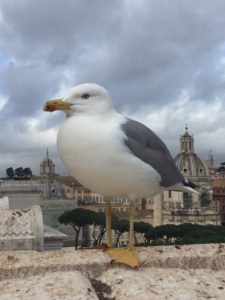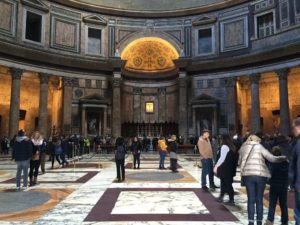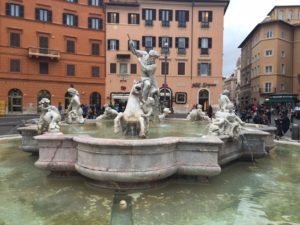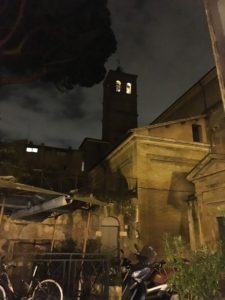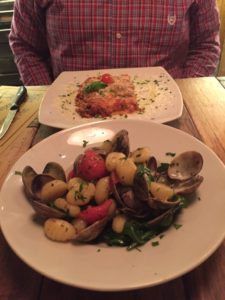It’s 1pm Saturday London time. Dan and I are having lunch in the British Airways lounge. He’s playing a video game on his iPad that he’s been obsessed with since Christmas. We have complimentary 15 minute massages scheduled for 1:40pm. (Him = scalp, me = neck and shoulders.) Traveling with Dan has its perks.
I was experiencing trouble getting on the internet earlier, and wrote the “final thoughts” entry first in Word. Turns out it was a browser issue; don’t why I didn’t think of that. Thanks, Dan :)
So now I’m back to writing about the last day of the trip – Friday. I woke up a good 95% over my cold; Dan was feeling much better as well. We took our time getting out of the hotel, leaving about 10am. Despite a late-ish start, we intended to pack in as much as we could. And since we were indoors most of the day Thursday, and the forecast was supposed to be generally good, we wanted to be outside as much as possible.
We picked a route that included a transfer at the train station, so we could get our tickets for the airport for this morning. We took a bus to the train station. We managed to keep the pickpocketers at bay (read the next entry for more info!), got our tickets and got out of there. From there we took the subway to the Colosseum.
So let’s start with the name. It’s not that because of it’s size. It’s Colosseum because there was a statue of Nero that sat outside of it that was called Colossus because of it’s size, and the name sort of transferred over. We also learned that, contrary to popular belief, there’s no evidence that Christians were fed to lions in the Colosseum. There were primarily two kinds of games: with animals, which could be animals fighting animals or men fighting animals, or gladiators. And sometimes prisoners were used as contestants. And yes Christians were persecuted during this time. But fed to lions? No evidence of that. Historians believe that when (whichever) Pope declared the Colosseum a sacred Christian place in 1750, because Popes could do that, that story got made up.
As a side note, the influence of popes on this town over the centuries is phenomenal and probably not all that surprising, but more than any other place that we’ve been, you really get here that for the first 1500 years or so of western civilization, there was zero separation between church and state. I don’t remember where we picked up this little tidbit, but somewhere we read that St. Peter’s was largely financed by a bishop put in charge of selling indulgences. His type of salesmanship and success in this area because so scandalous it led to, among other things, Martin Luther’s 95 Theses which is generally considered the kick off of the Reformation. Sorry, I probably shouldn’t be as amused by that as I was. (I found that independently here, which also explains indulgences if you’re not familiar with the term in this context.)
Let’s get on to photos before I go too much further down that diatribe. The Colosseum.
We took this as we were leaving, but it seemed odd not to start with a photo of it from the outside. It was built around 50AD, and much used until about 300AD. After Constantine, who legalized Christianity and wanted a more peaceful life for Romans, it’s barbaric practices ceased and was used for other religious and community events. By 500 or so it was completely abandoned. Over the centuries, it was pilfered for it’s building materials and used in other construction around the city – including St. Peter’s.
A partial wooden stage has been built to mimic would would have covered the entire floor of the arena when it was in use. Arena is Latin for sand, which covered the wood which covered the complex system of mechanics, cages and passageways underneath.
Underneath the area were cages for the animals, passages for animals and contestants, and a complex system of pulleys, etc., that moved things up and out when needed for the games.
Looking out over the Forum, which we went to later.
It’s wild to think about what it must have been like to live in those times.
It’s also wild to think about how fairly sophisticated their architecture and mechanical engineering was during this time. Yet somehow we went from this to the Dark Ages and, as a civilization, made very little progress until the Renaissance – which was all based on returning to this level of thinking and progress.
A senator’s initials. Each had their designated seat.
This is a remnant of a man on a horse structure. The cross in the background was put there in 2000.
Palatine Hill and The Forum are essentially next door and all on the same ticket. The entire area is a study in Roman History, and therefore the history of western civilization, from it’s beginnings around 750BC to the fall of the Roman Empire during the 400s.
Arch of Constantine, built between 312-315. This sits between the Colosseum and the beginning of Palatine Hill.
Palatine Hill contains evidence of the earliest settlements in Rome, dating back to 1000 AD. According to legend, the cave where Romulus and Remus were found is on this hill. It’s also the origin of words like palace, plaza and piazza. Today it is many acres of Roman ruins, with a little museum as well.
This picture in the museum gave an idea of what the area might have looked like around 100 AD.
This was once a fountain in front of a villa. There are steps on either side leading up to the home, and not too far into it another fountain seen below.
The Roman Forum was a plaza in the center of ancient Rome that was also the center of life in the city. All significant city events happened there, and important buildings surrounded it. Today all that’s left is pieces but with some imagination you can get glimpses into what it must’ve looked like. In the background to the left – the sand colored building with the tower – is the Capitoline Museum, where we were last night. The building next to it – white marble with the horses on top – is another museum. Whose name escapes me now, again.
Dan really loved this whole area. If you read Thursday’s entry, we’d seen this area at night from one of those arches on the left in the background and wondered how to get here. Now we know!
We wanted to be up there with those people but ran out of time. We spent a good 2 hours in this whole area, including the stop in the museum (which was really small).
They loved their arches.
That museum whose name we can never quite get was next door. It wasn’t on the pass we had and didn’t want to pay to go in. But it did have a café and it was lunch time. We’ve had great luck and back luck with museum cafes. This would fall on the bad luck side. But the seagulls on the balcony were not afraid of people. This photo is not zoomed or cropped. That’s how close we were.
That museum was high on a hill, at least in the back, and this was part of the walk down.
Full view of it from the front. It’s pretty impressive.
The Pantheon is the only building from Ancient Rome that’s still in use. It was built around 125, and still holds the record for having the largest unreinforced concrete dome.
While originally just a meeting hall, around 700 a church was added – St. Mary and the Martyrs.
We had decided early on that today we could get gelato twice and try to catch up before we leave! At the recommendation of a friend (thanks, Meher!) we came here, which was just a few blocks away from the Pantheon. Dan said it was the best pistachio ice cream he’s ever had. We didn’t care for the atmosphere though, which is hard to describe beyond crowded and frenetic.
Piazza Navona is a large plaza with two fountains in it, and of course a church. This was the first statue we came across, of Neptune. Back above, front below.
This the Fountain of the Four Rivers, a Bernini, constructed around 1650. These rivers represent the world, each from a different continent: Danube, Ganges, Nile, Rio de la Plata.
As we were making our way via buses to a neighborhood across the river, we ended up at a central bus stop we’d been at several times before. We’d seen these two girls take this picture yesterday and Dan thought we should try it, too.
This is at the bottom of the steps leading up to Capitoline Museum.
We had done a lot of walking through various neighborhoods in the central city and realized that’s one of the things that we most love doing and haven’t had time on this trip. We decided to spend the evening in Trastavere, a neighborhood across the river (the Tiber, by the way), which was highly recommended by the hop-on-hop-off bus tour as well as TripAdvisor. We spent a couple of hours walking around and it was very charming. We had dinner there as well.
Santa Maria
There was a mass going on.
These girls did several dances with fire in the plaza outside the church. They were pretty good and had gathered quite a crowd around them,
The view we had from our dinner table outside – until the smokers drove us in!
Our final meal. Dan had gnocchi and clams, I had lasagna. The foot was great, the place was noisy though,
Saw this on our way out of Trastavere. Had never seen this before: a restaurant based on toast.
One final shot of St. Peter’s as we headed over the bridge.
This is Campo de’Fiori. This holds a daily public market during the day but just restaurants at night. A few blocks from here we found the #1 Gelato place in Rome according to TripAdvisor, for our final fix of the trip: La Gelateria Frigidarium. We forgot to take a picture. Dan said his pistachio there was better than Giolitti’s (a mere 82 of 459 ice cream shops). It was great and definitely satisfying.
And that ends our 8 day tour of Italy. Four cities and really just 6.5 days on the ground once you back out travel time. Overall the amount of time was great; the number of cities a little ambitious. But it worked for us. We don’t have a need to return to the first 3, but we will definitely come back to Rome.
There will be one more entry to share some final thoughts and photos from the way home.
PS: I finished this when we got home, about 10:30pm Sacramento time Saturday. It would be 7:30am in Italy. I got 3-4 hours of sleep on the plane ride home, so hoping that was enough to take the edge off and stay up late enough to get my body back on Pacific time early. Dan is already asleep; he has a 7am flight to Raleigh tomorrow, and we’re doing laundry in between.











